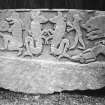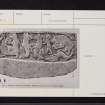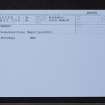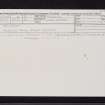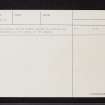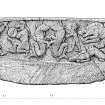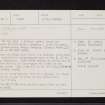Pricing Change
New pricing for orders of material from this site will come into place shortly. Charges for supply of digital images, digitisation on demand, prints and licensing will be altered.
Upcoming Maintenance
Please be advised that this website will undergo scheduled maintenance on the following dates:
Thursday, 9 January: 11:00 AM - 3:00 PM
Thursday, 23 January: 11:00 AM - 3:00 PM
Thursday, 30 January: 11:00 AM - 3:00 PM
During these times, some functionality such as image purchasing may be temporarily unavailable. We apologise for any inconvenience this may cause.
Gellyburn
Chapel (Period Unknown)(Possible), Composite Slab Shrine (Early Medieval)(Possible), Pictish Symbol Stone (Pictish)
Site Name Gellyburn
Classification Chapel (Period Unknown)(Possible), Composite Slab Shrine (Early Medieval)(Possible), Pictish Symbol Stone (Pictish)
Alternative Name(s) Gellyburn Farina Works/murthly Estate
Canmore ID 26982
Site Number NO03NE 6
NGR NO 093 392
NGR Description NO c. 093 392
Datum OSGB36 - NGR
Permalink http://canmore.org.uk/site/26982
- Council Perth And Kinross
- Parish Little Dunkeld
- Former Region Tayside
- Former District Perth And Kinross
- Former County Perthshire
Murthly 1, Gellyburn, Perthshire, carved panel
Measurements: L 1.12m, H 0.61m, D 0.10m
Stone type: sandstone
Place of discovery: NO c 093 392
Present location: National Museums Scotland, Edinburgh (IB 101)
Evidence for discovery: found during ploughing in 1886 near the confluence of the Gelly Burn with the River Tay.
Present condition: worn but the relief carving is intact. A few plough scratches.
Description
One broad face of this slab is carved in relief within a plain flatband border, leaving a deep uncarved lower part of the slab. In the centre of the panel is a pair of confronting sea-horses with fish tails, ears, fins and forelegs touching. To their left are two fighting human figures, one with a bird head and the other an animal head, who are armed with swords and circular shields. To the right of the sea-horses is a naked man pursued by a ferocious beast, and a goggle-eyed serpentine creature with a fish tail. This panel may belong to the same shrine or screen as the panel from Pittensorm Farm, Murthly 3. All three carved stones, Murthly 1-3, may have come from an early church site located close to the confluence of the Gelly Burn with the River Tay.
Date: ninth century.
References: Hutcheson 1887; ECMS pt 3, 305-6.
Compiled by A Ritchie 2016
NO03NE 6 c.093 392.
See also NO03NE 1.
(Area: NO 093 392) A Pictish symbol stone was discovered in 1886 while ploughing a field belonging to Gellyburn Farina Works, Murthly. (Farina Works (O G S Crawford, 12 October 1939) situated at NO 0947 3928).
The stone was found just below the surface, lying E-W, with a similar but unsculptured slab to the S of it, closely adjoining. Both slabs rested on stones set on edge, but nothing of importance was found in the enclosed space. The stone is in the National Museum of Antiquities of Scotland (NMAS: 1B101).
The site is traditionally that of a chapel, but there is no trace of any buildings or any information regarding it. (See also NO03NE 1 for another stone found in this area in 1949).
A Hutcheson 1886; Proc Soc Antiq Scot 1887
Enquiries at Murthly Estate Office failed to provide any further information on the stone or the chapel.
Visited by OS (RD) 14 March 1969.













